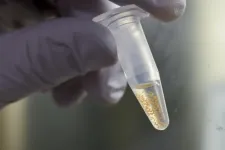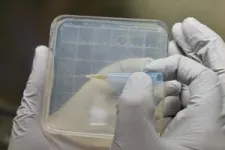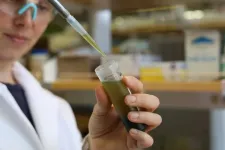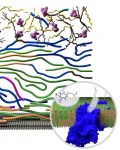(Press-News.org) Researchers at Michigan State University have discovered two proteins that work together to determine the fate of cells in plants facing certain stresses.
Ironically, a key discovery in this finding, published recently in Nature Communications, was made right as the project's leader was getting ready to destress.
Postdoctoral researcher Noelia Pastor-Cantizano was riding a bus to the airport to fly out for vacation, when she decided to share a promising result she had helped gather a day earlier.
“I didn’t want to wait ten days until I came back to send it. It took almost two years to get there,” said Pastor-Cantizano, who then worked in the Brandizzi lab in the MSU-DOE Plant Research Laboratory, or PRL.
"That's what I remember at the moment," Pastor-Cantizano said. "I was thinking 'I can relax now, at least for one week.'
Pastor-Cantizano had been working identify a gene in the model plant Arabidopsis that could control the plants response to stressors, which can lead to the plant’s death. She and her collaborators had identified a protein in Arabidopsis that seemed to control whether a plant would live or die under stress conditions.
Having identified the gene was just the beginning of the story, despite being years into the journey. It would take five more years to get to this new paper.
The researchers discovered that the proteins BON-associated protein2, or BAP2, and inositol-requiring enzyme 1, or IRE1, work together when dealing with stress conditions — a matter of life and death for plant cells.
Understanding how these proteins function can help researchers breed plants that are more resilient to death conditions.
Creating plants that are more resistant to endoplasmic reticulum stress, or ER stress, has widespread implications in agriculture. If crops can be made to be more resilient in the face of drought or heat conditions, the plants stand a better chance of surviving and thriving, despite the changing climate.
“Research in our lab is fueled by enthusiasm and gratitude to be able to make important contributions to science,” said Federica Brandizzi, MSU Research Foundation Professor in the Department of Plant Biology and at the PRL. “The work was herculean, and has been possible only thanks to the patience, enthusiasm and dedication of a wonderful team. Noelia was simply fantastic.”
Working in tandem
Within eukaryotic cells is an organelle known as the endoplasmic reticulum, or ER. It creates proteins and folds them into shapes the cell can utilize. Like cutting up vegetables to use in a recipe, the proteins must be formed into the right shape before they can be used.
Protein making and protein folding capacity must be in balance, like a sous chef and a chef, working in tandem. If the sous chef is providing the chef with too little or too many ingredients, it throws off the balance in the kitchen.
When the ER cannot properly do its job, or the balance is thrown off, it enters a state known as ER stress. The cell will jumpstart a mechanism known as the unfolded protein response, or UPR, to decide what to do next. If the problem can be resolved, the cell will initiative life saving measures to resolve the problem. If it cannot be, the cell begins to shut down, ending its and potentially the plant’s life.
It was known that the enzyme IRE1 was responsible for directing the mechanisms that would either save the cell or kill it off.
But what calls IRE1 to action?
In this study, the Brandizzi lab researchers were searching for the master regulator of these pro-death processes, known as programmed cell death.
“I had the idea because I read that irritable bowel disease is linked to a mutation in a gene controlled by IRE1 that occurs among humans,” Brandizzi said. “Humans are diverse and so are plants. So I thought to look into plant diversity as a source of new important findings in the UPR.”
The researchers started by looking at hundreds of accessions, or plants of the same species but specific to one locale. For example, a plant that grows in Colombia will have genetic variations to the same species of plant that grows in Spain, and the ways they each respond to stress conditions could differ.
They found extensive variation in the response to ER stress between the different accessions. Taking the accessions whose responses were the most dissimilar, they tried to identify the differences in their genomes. This is where the BAP2 gene candidate came into play.
“We found that BAP2 responds to ER stress,” said Pastor-Cantizano, who is currently a postdoc at the University of Valencia. “And the cool thing is that it is able to control and modify the activity of IRE1. But also IRE1 is able to regulate BAP2 expression.”
BAP2 and IRE1 work together, signaling to each other what the best course of action for the cell is. Having one without the other results in the death of the plant when the ER homeostasis is unbalanced.
Seven years
From start to finish, this project took over seven years of dedicated work.
Day in and out, the researchers spent their time tediously placing seeds onto plates with a medium in which they could grow. Arabidopsis seeds are not much larger than grains of sand at their smallest, so this was delicate work that required time and attention.
From there, the researchers spent several more months with these plants, looking at the accessions offsprings and identifying how BAP2 worked within the plants. This took another few years.
“It has been a long road with its obstacles, but it has been worth it,” said Pastor-Cantizano. “When I started this project, I couldn't imagine how it would end.”
This work was funded by the National Institutes of Health, with contributing support from Chemical Sciences, Geoscience and Biosciences Division, Office of Basic Energy Sciences, Office of Science, U.S. Department of Energy; the Great Lakes Bioenergy Research Center, U.S. Department of Energy, Office of Science, Office of Biological and Environmental Research; and MSU AgBioResearch. Additional contributing support comes from the Generalitat Valenciana, “European Union NextGenerationEU/PRTR.”
END
Discovering how plants make life-and-death decisions
2024-08-07
ELSE PRESS RELEASES FROM THIS DATE:
National Academies progress report: Health disparities
2024-08-07
Irvine, Calif., Aug. 7, 2024 — From costing society an estimated $11 trillion to hindering new discoveries in medicine and preventing access to effective interventions, underrepresentation of women, older adults and minorities in clinical research has several significant consequences, according to recent analyses commissioned by the National Academies of Sciences, Engineering and Medicine.
Jonathan Watanabe, UC Irvine professor of clinical pharmacy practice and director of the campus’s Center for Data-Driven Drugs Research and Policy, ...
Lemurs use long-term memory, smell, and social cues to find food
2024-08-07
How do foraging animals find their food? A new study by New York University researchers shows that lemurs use smell, social cues, and long-term memory to locate hidden fruit—a combination of factors that may have deep evolutionary roots.
“Our study provides evidence that lemurs can integrate sensory information with ecological and social knowledge, which demonstrates their ability to consider multiple aspects of a problem,” said anthropologist Elena Cunningham, a clinical professor of molecular pathobiology at NYU College of Dentistry and the lead author of the study, published in the International Journal of Primatology.
Animals rely on ...
New research challenges conventional wisdom on wet surface adhesion
2024-08-07
Scientists at the University of Akron and the University of Pittsburgh have overturned long-held assumptions in new research that finds water can be a help for adhesion.
Dr. Ali Dhinojwala, distinguished W. Gerald Austen Endowed Chair and H.A. Morton Professor at The University of Akron’s School of Polymer Science and Polymer Engineering, lead a team whose significant breakthrough — that water can unexpectedly enhance adhesion under controlled conditions — was published Aug. 7 in Science Advances.
The implications of this research are profound, particularly in biomedical applications ...
Newly published report outlines findings from first archaeology project in space
2024-08-07
The first-ever archeological survey in space has provided new insights into how astronauts use and adapt their living space on the International Space Station, which could influence the design of new space stations after the ISS is decommissioned.
Findings from the research team behind the International Space Station Archaeological Project (ISSAP) were published today in the journal PLOS ONE. Archaeologist Justin Walsh of Chapman University is available to discuss the discoveries of the team’s first on-orbit project, the Sampling Quadrangle Assemblages Research Experiment (SQuARE).
While Earth-bound archaeologists dig one-meter squares to understand ...
Memory loss in aging and dementia: Dendritic spine head diameter predicts memory in old age
2024-08-07
BIRMINGHAM, Ala. – Over the course of life, memory fades with varying degrees, robbing older people of the ability to recollect personal experiences. This progressive, nearly inevitable process has long been hypothesized as a consequence of nature’s removal of dendritic spines, a key component of synapses, from brain neurons as they age.
A study published in Science Advances led by researchers at the University of Alabama at Birmingham and Rush University Medical Center, Chicago, Illinois, now provides evidence that the preservation of past life experiences ...
Birmingham host to investigational treatment trial which could improve outcomes of pregnancies affected by severe haemolytic disease
2024-08-07
Pregnant mothers have taken part in a clinical study (the UNITY trial) in Birmingham, which has found that nipocalimab, an investigational, fully human, monoclonal antibody, has the potential to improve the survival rate of unborn babies with rare, early-onset fetal anaemia, as a result of haemolytic disease of the fetus and newborn (EOS-HDFN).
The study investigated pregnancies complicated by severe EOS-HDFN (RhD (D) or Kell (K) alloimmunized pregnant individuals with singleton pregnancies) and evaluated the effects of nipocalimab at weekly intervals from 14-35 ...
Drug trial for rare fetal blood disease shows promise for less invasive approach
2024-08-07
AUSTIN, Texas — Data from a new investigational drug that could alter the standard treatment for a rare blood disease suggests it has the potential to delay or prevent anemia and the need for intrauterine blood transfusions in babies who are at high risk for the condition, known as Hemolytic Disease of the Fetus and Newborn (HDFN). Results of the Phase 2 clinical trial of the drug nipocalimab were published today in The New England Journal of Medicine.
HDFN is a serious condition in which the blood types of the mother and her fetus do not match, potentially causing life-threatening anemia in the baby. The current ...
Forever chemical pollution can now be tracked
2024-08-07
Organofluorine compounds — sometimes called ‘forever chemicals’ — are increasingly turning up in our drinking water, oceans and even human blood, posing a potential threat to the environment and human health.
Now, researchers at The University of Texas at Austin have developed a way to fingerprint them, which could help authorities trace them to their source when they end up in aquifers, waterways or soil.
The technique involves passing samples through a strong magnetic field then reading the burst of radio waves their atoms emit. This reveals ...
How fungi elude antifungal treatments
2024-08-07
Every year, life-threating invasive fungal infections afflict more than 2 million individuals globally. Mortality rates for these infections are high, even when patients receive treatment.
Aspergillus fumigatus, the most frequent cause of invasive fungal infection in people with suppressed immune systems, is responsible for approximately 100,000 deaths annually around the world. Poor treatment outcomes result from therapeutic failures and the fungi’s resistance to existing drugs.
A new multi-institutional study led by researchers at Michigan State University has characterized how fungi adapt to restructure their cell walls, effectively ...
ACC Asia 2024 explores emerging trends, evidence-based strategies for improving global heart health
2024-08-07
The American College of Cardiology (ACC) and the Cardiological Society of India will host ACC Asia 2024 on August 16-18 in Delhi, India. This conference will bring together all members of the cardiac care team to examine emerging trends and best practices for cardiovascular disease patient care.
“One of the most meaningful outcomes of the annual ACC Asia conference is the ability to communicate with other cardiologists to strategize and innovate new ideas,” said Eugene Yang, MD, MS, FACC, one of the ACC Asia conference co-chairs. “As ...





